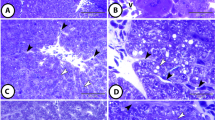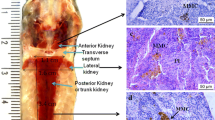Abstract
Melanomacrophage centres (MMCs) are formed by macrophage aggregates containing pigments such as hemosiderin, melanin and lipofuscin. MMCs are found in animals such as reptiles, amphibians and, mainly, fishes, in organs such as the kidney, spleen, thymus and liver. In teleost fish, several functions have been attributed to MMCs, including the capture and storage of cations, the phagocytosis of cellular debris and immunological reactions. As the use of MMCs has been suggested as a tool for the assessment of environmental impacts, our aim has been to describe the various metabolic processes performed by MMCs in diverse organs (liver and spleen) by using the teleost Prochilodus argenteus as an animal model. MMCs from the liver and spleen were assessed by histochemistry, transmission electron microscopy, scanning electron microscopy, X-ray microanalysis techniques and biochemical assay for N-acetylglucosaminidase activity. The data showed metabolic differences in MMCs between the liver and spleen of P. argenteus in their morphometric characteristics and biochemical and elemental composition. The implications of these findings are discussed, focusing on their role in organ metabolism.








Similar content being viewed by others
References
Agius C (1985) The melano-macrophage centres in fish: a review. In: Manning MJ, Tatner MF (eds) Fish immunology. Academic Press, London, pp 85–105
Agius C, Roberts RJ (2003) Melano-macrophage centres and their role in fish pathology. J Fish Dis 26:499–509
Aisen P, Enns C, Wessling-Resnick M (2001) Chemistry and biology of eukaryotic iron metabolism. J Biochem Cell Biol 33:940–959
Blazer VS (2002) Histopathological assessment of gonadal tissue in wild fishes. Fish Physiol Biochem 26:85–101
Bruslè J, Anadon GG (1996) The structure and function of fish liver. In: Munshi JSD, Dutta HM (eds) Fish morphology. Science, New York, pp 77–93
Bucke D, Vethaak AD, Lang T (1992) Quantitative assessment of melanomacrophage centres (MMCs) in dab Limanda limanda along a pollution transect in the German Bight. Mar Ecol Prog Ser 91:193–196
Corrêa JD Jr, Allodi S, Farina M (2003) Enzymatic, analytical and structural aspects of electron-dense granules in cells of Ucides cordatus (Crustacea, Decapoda) hepatopancreas. Cell Tissue Res 311:107–116
Corrêa JD Jr, Bruno MI, Allodi I, Farina M (2009) Effects of H+ concentration on amorphous mineral granules: structural stability and elemental mobilization. J Struct Biol 166:59–66
Ding L, Kuhne WW, Hinton DE, Song J, Dynan WS (2010) Quantifiable biomarkers of normal aging in the Japanese medaka fish (Oryzias latipes). PLoS One 5:1–11
Drevnick PE, Roberts AP, Otter RR, Hammerschmidt CR, Klaper R, Oris JT (2008) Mercury toxicity in livers of northern pike (Esox lucius) from Isle Royale, USA. Comp Biochem Physiol 147:331–338
Fishelson L (2006) Cytomorphological alterations of the thymus, spleen, head-kidney, and liver in cardinal fish (Apogonidae, Teleostei) as bioindicators of stress. J Morphol 267:57–69
Fournie JW, Summers JK, Courtney LA, Engle VD (2001) Utility of splenic macrophage aggregates as an indicator of fish exposure to degraded environments. J Aquat Anim Health 13:105–116
George SG (1982) Subcellular accumulation and detoxication of metals in aquatic animals. In: Vernberg WB, Calabrese A, Thurberg FP, Vernberg FJ (eds) Physiological mechanisms of marine pollutant toxicity. Academic Press, New York, pp 3–52
Haaparanta A, Valtonen ET, Hoffaman R, Colmes J (1996) Do macrophages centres in freshwater fishes reflect the differences in water quality? Aquat Toxicol 34:253–272
Haugarvoll E, Thorsen J, Laane M, Huang Q, Koppang EO (2006) Melanogenesis and evidence for melanosome transport to the plasma membrane in a CD83+ teleost leukocyte cell line. Pigment Cell Res 19:214–225
Herraez MP, Zapata AG (1986) Structure and function of the melanomacrophage centres of the goldfish Carassius auratus. Vet Immunol Immunopathol 12:117–126
Johnson MK (1998) Iron-sulfur proteins: new roles for old clusters. Curr Opin Chem Biol 2:173–181
Leknes IL (2001) The uptake of foreign ferritin by macrophages in the spleen, trunk kidney and liver of platy. J Fish Biol 59:1412–1415
Leknes IL (2004) Melano–macrophage centers in the liver of platyfish, Xiphophorus maculatus, poeciliidae: telesotei. Zoology 107:201–204
Leknes IL (2007) Melano-macrophage centres and endocytic cells in kidney and spleen of pearl gouramy and platyfish (Anabantidae, Poeciliidae: Teleostei). Acta Histochem 109:164–168
Loumbourdis NS, Vogiatzis AK (2002) Impact of cadmium on liver pigmentary system of the frog Rana ridibunda. Ecotoxicol Environ Saf 53:52–58
Luna LG (1968) Manual of histologic staining methods of the Armed Forces Institute of Pathology, 3rd edn. McGraw-Hill, New York
Rabitto IS, Alves-Costa JRM, Silva de Assis HC, Pelletier É, Akaishi FM, Anjos A, Randi MAF, Oliveira-Ribeiro CA (2005) Effects of dietary Pb(II) and tributyltin on neotropical fish, Hoplias malabaricus: histological and biochemical findings. Ecotoxicol Environ Saf 60:147–156
Roberts RJ (1975) Melanin-containing cells of the teleost fish and their relation to disease. In: Migaki G, Ribelin WE (eds) The pathology of fishes. University of Wisconsin, Madison, pp 55–91
Rosas ÁL, MacGill RS, Nosanchuk JD, Kozel TR, Casadevall C (2002) Activation of the alternative complement pathway by fungal melanins. Clin Diagn Lab Immunol 9:144–148
Rund CR, Christiansen JL, Johnson JC (1998) In vitro culture of melanomacrophages from the spleen and liver of turtles: comments on melanomacrophage morphology. Pigment Cell Res 11:114–119
Russo RC, Alessandri AL, Garcia CC, Cordeiro BF, Pinho V, Cassali GD, Proudfoot AEI, Teixeira MM (2010) Therapeutic effects of evasin-1, a chemokine binding protein, in bleomycin-induced pulmonary fibrosis. Am J Respir Cell Mol Biol. doi:10.1165/rcmb.2009-0406OC
Sato Y, Godinho HP (2003) Migratory fishes of the São Francisco River. In: Carolsfelds J, Harvey B, Ross C, Baer A (eds) Migratory fishes of South America: biology, fisheries and conservation status. IDRC and World Bank, Victoria, pp 195–232
Sato Y, Bazzoli N, Rizzo E, Boschi MB, Miranda MOT (2005) Influence of the Abaeté River in the reproductive success of the neotropical migratory teleost Prochilodus argenteus in the São Francisco River, downstream from the Três Marias Dam, southeastern Brazil. River Res Applic 21:939–950
Stentiford GD, Longshaw M, Lyons BP, Jones G, Green M, Feist SW (2003) Histopathological biomarkers in estuarine fish species for the assessment of biological effects of contaminants. Mar Environ Res 55:137–159
Taylor MG, Simkiss K (1989) Structural and analytical studies on metal ion-containing granules. In: Mann S, Webb RJ, Williams RJP (eds) Biomineralization: chemical and biochemical perspectives. VCH, Weinheim, pp 427–460
Vigliano FA, Bermudez R, Quiroga MI, Nieto JM (2006) Evidence for melano-macrophage centres of teleost as evolutionary precursors of germinal centres of higher vertebrates: an immunohistochemical study. Fish Shellfish Immunol 21:467–471
Wolke RE (1992) Piscine macrophage aggregates: a review. Annu Rev Fish Dis 2:91–108
Acknowledgements
The authors are grateful to the Estação de Hidrobiologia e Piscicultura de Três Marias and the CODEVASF/CEMIG convention for assistance in fish sampling.
Author information
Authors and Affiliations
Corresponding author
Additional information
This study received financial support from CNPq and FAPEMIG (Brazilian Agencies for Science and Technology).
Electronic supplementary material
Below is the link to the electronic supplementary material.
Supplementary material 1
Liver sections of the same MMCs stained by (a) Perls’ technique for hemosiderin, (b) aldehyde fuchsin for lipofuscin (white arrows) and (c) Masson/Fontana stain for melanin (white arrows). Note the correspondence among the granule types of lipofuscin, hemosiderin and melanin distribution with the different techniques. Bars 17 μm (GIF 347 kb)
Supplementary material 2
Spleen sections of the same MMCs stained by (a) Perls’ technique for hemosiderin, (b) aldehyde fuchsin for lipofuscin (white arrows) and (c) Masson/Fontana stain for melanin (white arrows). Note the correspondence among the granule types of lipofuscin, hemosiderin and melanin distribution with the different techniques. Bars 17 μm (GIF 422 kb)
Supplementary material 3
Transmission electron micrographs of (a) a liver MMCs exhibiting electron-dense particulate granules resembling ferritin (b). The same area was examined by X-ray microanalysis (c); the spectrum shows the Fe, O and S characteristic peaks observed in intracellular ferritin deposits. C and Cl come from the epoxy resin and U and Os result from fixation and staining procedures. These data were obtained by using a Tecnai—G2-20 (FEI) transmission electron microscope with a coupled EDS system. (GIF 265 kb)
Rights and permissions
About this article
Cite this article
Ribeiro, H.J., Procópio, M.S., Gomes, J.M.M. et al. Functional dissimilarity of melanomacrophage centres in the liver and spleen from females of the teleost fish Prochilodus argenteus . Cell Tissue Res 346, 417–425 (2011). https://doi.org/10.1007/s00441-011-1286-3
Received:
Accepted:
Published:
Issue Date:
DOI: https://doi.org/10.1007/s00441-011-1286-3




